The 2001 Yellow
Perch Report
by Rick Kubb
| A BOAT LOAD of useful walleye information in each issue from seasoned tournament fishermen and Lake Erie fishing experts. |
|
Lake Erie Walleye Magazine |
|
The 2001 Yellow
Perch Report |
|
D
uring the mid-to-late 1980sthe yellow perch populations in Lake Erie were among the highest on record. Limit catches by fishermen were extremely common during that time. In the early to mid 1990’s the perch populations experienced a rapid decline.In recent years Fisheries Agencies have put forth efforts aimed at rehabilitating the perch population. In 1996 the state of Ohio posed a 30 perch daily bag limit. Similarly the State of Pennsylvania places an 8 inch minimum size limit and a 20 perch daily bag limit on perch. Tighter regulations were also levied on commercial fishermen.
In the past few years it is apparent that perch stocks are improving in Michigan, Ohio and in Pennsylvania waters of Lake Erie. Perch stocks are still low further east in New York waters.
This report represents our seventh consecutive year of reporting annual data on the status of yellow perch stocks in Lake Erie. The data used in this report have been obtained from official fisheries status reports obtained from Michigan, Ohio, Pennsylvania and New York fisheries agencies. These reports were produced in the spring of 2001 and the data in them represent the perch stocks as evaluated in the year 2000. As in previous years, we examine each state individually to obtain an overall view of the yellow perch fish stocks lake-wide.
Michigan Waters of Lake Erie
In general Lake Erie yellow perch abundance has been slowly on the increase
in Michigan waters of Lake Erie since 1992. From 1992 to 1998 the yellow perch
harvest increased from .25 million perch to .55 million perch. However catches
were lower in 1999 (.4 million perch) and lower yet in the year 2000 with an
estimated .22 million harvested perch (see figure 1).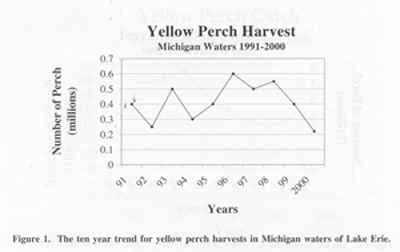
Charter boat anglers success rate for yellow perch was about double that of non-charter anglers during the 2000 season.
In the year 2000, the yellow perch harvest was dominated by age 4 fish (1996 year-class) in Michigan waters, accumulating 42% of all fish taken. In combination, age 2, 3 and 5 yellow perch contributed 52% of the harvest. The average length of harvested age 2,3 and 4 fish was 7.3 inches, 7.7 inches and 8.3 inches respectively.
Biologists suspect that the increased abundance of yellow perch in the western waters of Lake Erie has resulted in slightly slower growth of these fish, primarily the result of increased competition for food among perch and among other species.
In the year 2000, only one Michigan commercial fishing license was active on the Michigan waters of Lake Erie. This fisherman operated a commercial seine in the shallow embayments along Michigan’s Lake Erie Shoreline and harvested primarily ‘rough’ species such as carp, buffalo and catfish. The fisherman did not target nor had any impact on the yellow perch fishery.
This year (2001) the numbers of harvestable yellow perch in Michigan waters should increase due to the full recruitment of the 1998 hatch.
Ohio Waters of Lake Erie
Yellow perch abundance in Ohio waters improved again in 2000, relative to the
low numbers in the early 1990s due to successful reproduction in four of the
last six years and reduced fishing mortality. The strong 1996 year class was
mostly responsible for this increase. 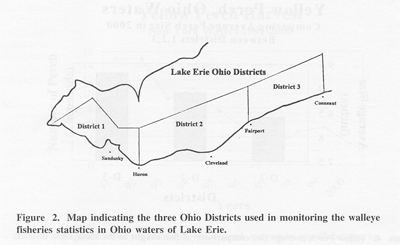 With
moderate reproduction success in 1998, the numbers of yellow perch available to
Ohio anglers in Lake Erie will be about the same as in 2000. Looking beyond the
year 2001, an average 1999 hatch and a below average hatch in 2000 will likely
result in slightly lower numbers of yellow perch available to fishermen in the
next couple of years.
With
moderate reproduction success in 1998, the numbers of yellow perch available to
Ohio anglers in Lake Erie will be about the same as in 2000. Looking beyond the
year 2001, an average 1999 hatch and a below average hatch in 2000 will likely
result in slightly lower numbers of yellow perch available to fishermen in the
next couple of years.
Ohio sport and commercial fishermen were within their allotted quotas in 2000 for the third consecutive year. The 30-fish daily bag limit is again in effect for 2001.
In 2000 the combined private and charter yellow perch harvest was 5.5 million
fish, nearly the same total as in 1999 (see figure 3). Private boat anglers
harvested an estimated 5.3 million yellow perch just slightly higher than the
5.2 million yellow perch caught in 1999. Charter anglers harvested about .2
million yellow perch in 2000. In 2000, anglers expended 1.7 million angler hours
targeting yellow perch. Again this is only slightly higher than the estimated
1.6 million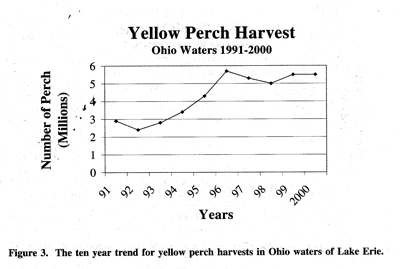 targeted angler hours in 1999.
targeted angler hours in 1999.
The 1996 year class made up 39% of the yellow perch harvest followed by the 1998 (28%) and the 1997 (21%) year classes.
Comparing Districts
The Ohio waters of Lake Erie are divided into three Districts (see figure 2). District 1 is comprised of the western basin, extending to Huron, OH. District 2 is in the central basin and extends from Huron to Fairport. District 3 extends from Fairport to Conneaut, OH.
Traditionally the greatest numbers of perch are harvested from the shallow western basin (District 1). In 2000 a total of 2.9 million perch (combined private & charter) were taken there. A total of 1.8 million fish were taken from District 2. A total of .7 million fish were harvested from District 3.
Generally, yellow perch harvested by sport anglers are larger as one moves
from west to east (see figure 3). In 2000 this trend continued. The average size
yellow perch caught in District 1 was 8.4 inches and .25 pounds. This increased
to 9 inches and .34 pounds in District 2. In District 3 perch taken by anglers
averaged 9.3 inches and .42 pounds.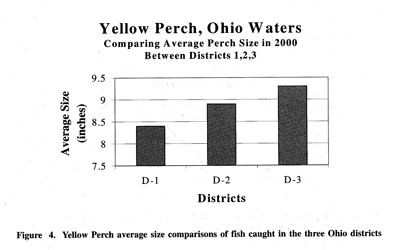
Commercial Harvest
In 2000 the total allocation to trap netters for yellow perch was 965,443 fish, the highest since the quota system was established. In District 1, a total of 240,578 pounds of yellow perch were harvested. In the central basin (combined Districts 2 & 3) a total of 721,618 pounds were harvested. The commercial harvest of yellow perch in Ohio waters was the highest in 10 years. The average trap net catch rate of 88 pounds/lift was more than double the ten-year average. The commercial harvest from District 2 accounted for 60% of the total commercial harvest for Ohio waters. The strong 1996 year class was the most abundant of the eight year-classes reported in the harvest.
Diet of Yellow Perch
The food that yellow perch consumed varied between the shallow western basin and
the deeper central basin. In the western basin, benthic macroinvertebrates made
up the majority of the diets of yellow perch in spring and fall with zooplankton
being consumed mainly in the early summer. The large mayfly nymph (Hexagenia)
was the primary benthic macroinvertebrate consumed by yellow perch.
In the central basin, yellow perch consumed mainly benthic invertebrates in the spring, switching to zooplankton and benthic invertebrates in the summer and fall. Adult yellow perch ate primarily benthic invertebrates (48%) and fish (51%) in the spring, switching to zooplankton (50%), fish (32%) and benthic invertebrates (19%) in the summer and fall.
Outlook for 2001
The excellent perch fishing anglers have experienced the past four years should
continue through 2001 and beyond. Conservative regulations for sport and
commercial fishers and improved spawns in the mid-to-late 1990s have helped Lake
Erie’s yellow perch stocks to gradually recover after low levels in the early
1990s.
Anglers can expect to see many fine catches of perch from a large 1996 year class, the largest hatch in 10 years. These fish will measure 8.5 to 10 inches. Added to the catch will be perch from the 1998 year class now in the 8-9 inch range.
Perch fishing will peak in September and October. The daily bag limit for yellow perch in Ohio waters will remain 30 fish/angler.
Pennsylvania Waters of Lake Erie
The 2000 fishing season provided an excellent yellow perch fishery for
anglers relative to recent history. During the 2000 fishing season, anglers
caught an estimated 169,824 perch (112,902 harvested). This represented a 172%
increase from the 1999 catch (see figure 5).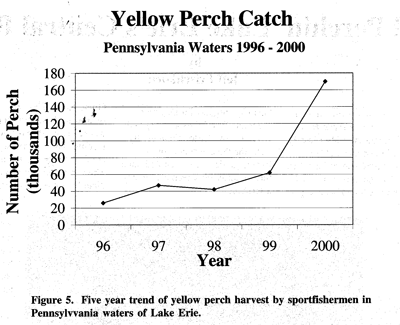
Yellow perch angling was concentrated mainly in the central basin waters where over 70% of the harvest occurred. Although only 30% of the perch were caught in the deeper eastern basin waters, the relative numbers of fish caught in the eastern basin waters also improved compared to 1999.
August and September accounted for over 80% of the perch harvest in Pennsylvania waters.
The average length perch caught in Pennsylvania waters was 9.4 inches. The 1994 year class (age 6) accounted for the greatest proportion (33%) of the perch harvest. The large 1996 year class and the 1995 year class also contributed to the catch.
The outlook for perch fishing in Pennsylvania waters for the new few years is very good. Strong year classes in 1996, 1998 and 1999 will fuel the perch population growth in the year 2001 and beyond.
Commercial Fishery
The total allowable catch of commercial yellow perch is set at only 29,000 pounds for 2001. It is anticipated that only around 20% of this total will actually be reached. In effect the commercial fishery for yellow perch in Pennsylvania waters in non-existent, at this point.
New York Waters of Lake Erie
The status of the yellow perch resource appears to have been improving in
recent years. Gill net and bottom trawling programs indicated that the abundance
of yellow perch is now increasing in eastern Lake Erie. However, it remains
uncertain whether this recent increase is the beginning of a long-term recovery
or simply the chance occurrence of two strong year classes within three years.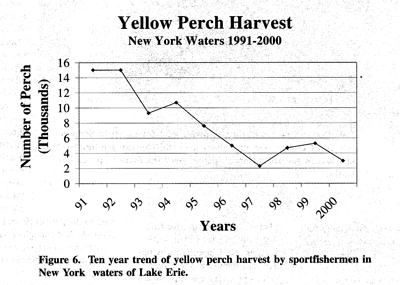
In 2000 in New York waters of Lake Erie, the yellow perch sport harvest remained very low with only 3,021 perch estimated to have been caught. This is lower than the estimated 5,360 yellow perch taken in 1999 (see figure 6). Fishing effort for yellow perch by anglers in 2000 was the lowest in 13 years. Of the few anglers that did fish for perch the relative size of yellow perch caught compared to points further to the west was high. The average size caught in New York waters in 2000 was 10.6 inches.